Land Subsidence and Its Relations with Sinkhole Activity in Karapınar Region, Turkey: A Multi-Sensor InSAR Time Series Study
Abstract
1. Introduction
2. Study Area
Geology
3. Data and Data Processing
3.1. InSAR Data
3.2. InSAR Data Processing
3.3. InSAR Time Series Analysis
3.4. GNSS Data Analysis
3.5. Groundwater-Level Data
4. Results
5. Discussion
6. Conclusions
Author Contributions
Funding
Institutional Review Board Statement
Informed Consent Statement
Data Availability Statement
Acknowledgments
Conflicts of Interest
References
- Gill, J.C.; Malamud, B.D. Anthropogenic processes, natural hazards, and interactions in a multi-hazard framework. Earth Sci. Rev. 2017, 166, 246–269. [Google Scholar] [CrossRef]
- Elmahdy, S.I.; Mohamed, M.M.; Ali, T.A.; Abdalla, J.E.D.; Abouleish, M. Land Subsidence and Sinkholes Susceptibility Mapping and Analysis Using Random Forest and Frequency Ratio Models in Al Ain, UAE. Available online: https://www.tandfonline.com/doi/abs/10.1080/10106049.2020.1716398 (accessed on 1 January 2021).
- Poland, J.F. Guidebook to Studies of Land Subsidence Due to Ground-Water Withdrawal; UNESCO, International Hydrological Programme: Paris, France, 1984. [Google Scholar]
- Amelung, F.; Galloway, D.L.; Bell, J.W.; Zebker, H.A.; Laczniak, R.J. Sensing the ups and downs of Las Vegas: InSAR reveals structural control of land subsidence and aquifer-system deformation. Geology 1999, 27, 483–486. [Google Scholar] [CrossRef]
- Törk, K.; Erduran, B.; Yılmaz, P.; Sülükçü, S.; Güner, İ.N.; Ateş, Ş.; Mutlu, G.; Keleş, S.; Çınar, A.; Demirbaş, Ş.; et al. Determination of Karst Depression Areas and Hazard Assessment in Konya Basin; Mineral Research and Exploration Institute: Ankara, Turkey, 2013; p. 320. (In Turkish) [Google Scholar]
- Baer, G.; Schattner, U.; Wachs, D.; Sandwell, D.; Wdowinski, S.; Frydman, S. The lowest place on Earth is subsiding—An InSAR (interferometric synthetic aperture radar) perspective. Geol. Soc. Am. Bull. 2002, 114, 12–23. [Google Scholar] [CrossRef]
- Closson, D.; Karaki, N.A.; Klinger, Y.; Hussein, M.J. Subsidence and sinkhole hazard assessment in the southern Dead Sea area, Jordan. Pure Appl. Geophys. 2005, 162, 221–248. [Google Scholar] [CrossRef]
- Al-Fares, R.A. The Utility of Synthetic Aperture Radar (SAR) interferometry in monitoring sinkhole subsidence: Subsidence of the Devil’s Throat Sinkhole Area (Nevada, USA). In Proceedings of the 10th Multidisciplinary Conference on Sinkholes and the Engineering and Environmental Impacts of Karst, San Antonio, TX, USA, 24–28 September 2005; pp. 541–547. [Google Scholar]
- Paine, J.G.; Buckley, S.; Collins, E.W.; Wilson, C.R.; Kress, W. Assessing sinkhole potential at Wink and Daisetta using gravity and radar interferometry. In Symposium on the Application of Geophysics to Engineering and Environmental Problems; Society of Exploration Geophysicists: Tulsa, OK, USA, 2009; pp. 480–488. [Google Scholar]
- Casu, F. The Small Baseline Subset technique: Performance Assessment and New Developments for Surface Deformation Analysis of very Extended Areas. Ph.D. Thesis, University of Cagliari, Cagliari, Italy, 2009. [Google Scholar]
- Castañeda, C.; Gutiérrez, F.; Manunta, M.; Galve, J.P. DInSAR measurements of ground deformation by sinkholes, mining subsidence, and landslides, Ebro River, Spain. Earth Surf. Process. Landf. 2009, 34, 1562–1574. [Google Scholar] [CrossRef]
- Osmanoğlu, B.; Dixon, T.H.; Wdowinski, S.; Cabral-Cano, E.; Jiang, Y. Mexico City subsidence observed with persistent scatterer InSAR. Int. J. Appl. Earth Obs. Geoinf. 2011, 13, 1–12. [Google Scholar] [CrossRef]
- Chaussard, E.; Amelung, F.; Abidin, H.; Hong, S.H. Sinking cities in Indonesia: ALOS PALSAR detects rapid subsidence due to groundwater and gas extraction. Remote Sens. Environ. 2013, 128, 150–161. [Google Scholar] [CrossRef]
- Liu, L.; Jafarov, E.E.; Schaefer, K.M.; Jones, B.M.; Zebker, H.A.; Williams, C.A.; Rogan, J.; Zhang, T. InSAR detects increase in surface subsidence caused by an Arctic tundra fire. Geophys. Res. Lett. 2014, 41, 3906–3913. [Google Scholar] [CrossRef]
- Qu, F.; Zhang, Q.; Lu, Z.; Zhao, C.; Yang, C.; Zhang, J. Land subsidence and ground fissures in Xi’an, China 2005–2012 revealed by multi-band InSAR time-series analysis. Remote Sens. Environ. 2014, 155, 366–376. [Google Scholar] [CrossRef]
- Üstün, A.; Tuşat, E.; Yalvaç, S.; Özkan, İ.; Eren, Y.; Özdemir, A.; Bildirici, İ.Ö.; Üstüntaş, T.; Kırtıloğlu, O.S.; Mesutoğlu, M. Land subsidence in Konya Closed Basin and its spatio-temporal detection by GPS and DInSAR. Environ. Earth Sci. 2015, 73, 6691–6703. [Google Scholar] [CrossRef]
- Yalvac, S. Validating InSAR-SBAS results by means of different GNSS analysis techniques in medium-and high-grade deformation areas. Environ. Monit. Assess. 2020, 192, 120. [Google Scholar] [CrossRef]
- Karimzadeh, S.; Matsuoka, M. Remote Sensing X-Band SAR Data for land subsidence and pavement monitoring. Sensors 2020, 20, 4751. [Google Scholar] [CrossRef]
- Ferretti, A.; Prati, C.; Rocca, F. Permanent scatterers in SAR interferometry. IEEE Trans. Geosci. Remote Sens. 2001, 39, 8–20. [Google Scholar] [CrossRef]
- Lanari, R.; Mora, O.; Manunta, M.; Mallorquí, J.J.; Berardino, P.; Sansosti, E. A small-baseline approach for investigating deformations on full-resolution differential SAR interferograms. IEEE Trans. Geosci. Remote Sens. 2004, 42, 1377–1386. [Google Scholar] [CrossRef]
- Yazici, B.V.; Tunc Gormus, E. Investigating persistent scatterer InSAR (PSInSAR) technique efficiency for landslides mapping: A case study in artvin dam area. Geocarto Int. 2020, 1–9. (In Turkey) [Google Scholar] [CrossRef]
- Awasthi, S.; Jain, K.; Mishra, V.; Kumar, A. An Approach for Multi-Dimensional Land Subsidence Velocity Estimation Using Time-Series Sentinel-1 SAR Datasets by Applying Persistent Scatterer Interferometry Technique. Available online: https://www.tandfonline.com/doi/abs/10.1080/10106049.2020.1831624 (accessed on 1 January 2021).
- Nonaka, T.; Asaka, T.; Iwashita, K.; Ogushi, F. Evaluation of the Trend of Deformation around the Kanto Region Estimated Using the Time Series of PALSAR-2 Data. Sensors 2020, 20, 339. [Google Scholar] [CrossRef]
- Berardino, P.; Fornaro, G.; Lanari, R.; Sansosti, E. A new algorithm for surface deformation monitoring based on small baseline differential SAR interferograms. IEEE Trans. Geosci. Remote Sens. 2002, 40, 2375–2383. [Google Scholar] [CrossRef]
- Kim, J.W.; Lu, Z.; Degrandpre, K. Ongoing deformation of sinkholes in Wink, Texas, observed by time-series Sentinel-1A SAR interferometry (preliminary results). Remote Sens. 2016, 8, 313. [Google Scholar] [CrossRef]
- Vajedian, S.; Motagh, M.; Hojati, A.; Wetzel, H.U. Multi-sensor technologies for analyzing sinkholes in Hamedan, west Iran. In Proceedings of the 19th EGU General Assembly conference, Vienna, Austria, 23–28 April 2017; p. 18878. [Google Scholar]
- Zhang, B.; Wdowinski, S.; Oliver-Cabrera, T.; Robinson, T.; Kruse, S.; Perissin, D. Monitoring Surface Stability of Remediated Sinkholes in Western Central Florida using PSInSAR Technique and Sentinel-1 Observations. In AGU Fall Meeting Abstracts; AGU: Washington, DC, USA, 2018; Volume 2018, p. G21C-0574. [Google Scholar]
- Nof, R.N.; Baer, G.; Ziv, A.; Raz, E.; Atzori, S.; Salvi, S. Sinkhole precursors along the Dead Sea, Israel, revealed by SAR interferometry. Geology 2013, 41, 1019–1022. [Google Scholar] [CrossRef]
- Nof, R.N.; Abelson, M.; Raz, E.; Magen, Y.; Atzori, S.; Salvi, S.; Baer, G. SAR interferometry for sinkhole early warning and susceptibility assessment along the Dead Sea, Israel. Remote Sens. 2019, 11, 89. [Google Scholar] [CrossRef]
- Oliver-Cabrera, T.; Wdowinski, S.; Kruse, S.; Robinson, T. InSAR Detection of Localized Subsidence Induced by Sinkhole Activity in Suburban West-Central Florida. Proc. Int. Assoc. Hydrol. Sci. 2020, 382, 155–159. [Google Scholar] [CrossRef]
- Orhan, O.; Dadaser-celik, F.; Ekercin, S. Investıgating land surface temperature changes using Landsat-5 data and real-time infrared thermometer measurements at konya closed basin in Turkey. Int. J. Eng. Geosci. 2019, 4, 16–27. [Google Scholar]
- Orhan, O.; Yakar, M.; Kırtıloglu, O.S. A Web Based Servıce Applıcatıon for Vısual Sınkhole Inventory Informatıon System; Case Study of Konya Closed Basın. Selcuk Univ. J. Eng. Sci. Technol. 2017, 5, 72–82. [Google Scholar] [CrossRef]
- Orhan, O.; Yakar, M.; Ekercin, S. An application on sinkhole susceptibility mapping by integrating remote sensing and geographic information systems. Arab. J. Geosci. 2020, 13, 1–17. [Google Scholar] [CrossRef]
- Yagmur, N.; Tanık, A.; Tuzcu, A.; Musaoğlu, N.; Erten, E.; Bilgilioglu, B. Oppurtunities provided by remote sensing data for watershed management: Example of konya closed basin. Int. J. Eng. Geosci. 2020, 5, 120–129. [Google Scholar]
- Caló, F.; Notti, D.; Galve, J.P.; Abdikan, S.; Görüm, T.; Pepe, A.; Balik Şanli, F. Dinsar-based detection of land subsidence and correlation with groundwater depletion in konya plain, turkey. Remote Sens. 2017, 9, 83. [Google Scholar] [CrossRef]
- Tapur, T.; Bozyigit, R. Konya Province Sinkhole Inventory—Report. 8 st Regional Directorate of Nature Conservation and National Parks, Konya; Nature Conservation and National Parks Konya Branch Office: Konya, Turkey, 2013. (In Turkish) [Google Scholar]
- Orhan, O.; Kırtıloğlu, O.S.; Yakar, M. Konya Kapalı Havzası Obruk Envanter Bilgi Sisteminin Oluşturulması. Geomatik 2020, 5, 92–104. [Google Scholar] [CrossRef]
- Ozdemir, A. Sinkhole susceptibility mapping using logistic regression in Karapınar (Konya, Turkey). Bull. Eng. Geol. Environ. 2016, 75, 681–707. [Google Scholar] [CrossRef]
- Gokmen, M.; Vekerdy, Z.; Verhoef, A.; Verhoef, W.; Batelaan, O.; Van der Tol, C. Integration of soil moisture in SEBS for improving evapotranspiration estimation under water stress conditions. Remote Sens. Environ. 2012, 121, 261–274. [Google Scholar] [CrossRef]
- Orhan, O. Uzaktan Algılama ve Coğrafi Bilgi Sistemleri ile Muhtemel Obruk Alanlarının Belirlenmesi. Ph.D. Thesis, Selçuk Üniversitesi Fen Bilimleri Enstitüsü, Konya, Turkey, 2018. (In Turkish). [Google Scholar]
- Ulu, U.; Bulduk, A.; Ekmekçi, E.; Karakaş, M.; Öcal, H.; Arbas, A.; Saçlı, L.; Taşkıran, A.; Adır, M.; Sözeri, Ş. Geological Report of İnlice-Akkise and Cihanbeyli-Karapınar Area, General Directorate of Mineral Research and Exploration (MTA) Report 9720, 219; Mineral Research Exploration Institute: Ankara, Turkey, 1994. [Google Scholar]
- Rosen, P.A.; Hensley, S.; Peltzer, G.; Simons, M. Updated repeat orbit interferometry package released. Eos Trans. Am. Geophys. Union 2004, 85, 47. [Google Scholar] [CrossRef]
- Yunjun, Z.; Fattahi, H.; Amelung, F. Small baseline InSAR time series analysis: Unwrapping error correction and noise reduction. Comput. Geosci. 2019, 133, 104331. [Google Scholar] [CrossRef]
- Farr, T.G.; Rosen, P.A.; Caro, E.; Crippen, R.; Duren, R.; Hensley, S.; Shaffer, S.; Shimada, J.; Umland, J.; Werner, M.; et al. The Shuttle Radar Topography Mission. Available online: https://agupubs.onlinelibrary.wiley.com/doi/full/10.1029/2005rg000183 (accessed on 1 January 2021).
- Bamler, R.; Hartl, P. Synthetic aperture radar interferometry. Inverse Probl. 1998, 14, R1. [Google Scholar] [CrossRef]
- Pepe, A.; Lanari, R. On the extension of the minimum cost flow algorithm for phase unwrapping of multitemporal differential SAR interferograms. IEEE Trans. Geosci. Remote Sens. 2006, 44, 2374–2383. [Google Scholar] [CrossRef]
- Eshqi Molan, Y.; Kim, J.W.; Lu, Z.; Agram, P. L-band temporal coherence assessment and modeling using amplitude and snow depth over Interior Alaska. Remote Sens. 2018, 10, 150. [Google Scholar] [CrossRef]
- Geudtner, D.; Torres, R. Sentinel-1 system overview and performance. In Proceedings of the 2012 IEEE International Geoscience and Remote Sensing Symposium, Munich, Germany, 22–27 July 2012; pp. 1719–1721. [Google Scholar]
- Hanssen, R.F. Radar Interferometry: Data Interpretation and Error Analysis; Springer Science & Business Media: Berlin/Heidelberg, Germany, 2001; Volume 2. [Google Scholar]
- Pepe, A.; Bonano, M.; Zhao, Q.; Yang, T.; Wang, H. The use of C-/X-band time-gapped SAR data and geotechnical models for the study of Shanghai’s ocean-reclaimed lands through the SBAS-DInSAR technique. Remote Sens. 2016, 8, 911. [Google Scholar] [CrossRef]
- Herring, T.A.; King, R.W.; McClusky, S.C. Introduction to Gamit/Globk; Massachusetts Institute of Technology: Cambridge, MA, USA, 2010. [Google Scholar]
- Hoffmann, J.; Zebker, H.A.; Galloway, D.L.; Amelung, F. Seasonal subsidence and rebound in Las Vegas Valley, Nevada, observed by synthetic aperture radar interferometry. Water Resour. Res. 2001, 37, 1551–1566. [Google Scholar] [CrossRef]
- Chaussard, E.; Bürgmann, R.; Shirzaei, M.; Fielding, E.J.; Baker, B. Predictability of hydraulic head changes and characterization of aquifer—system and fault properties from InSAR—Derived ground deformation. J. Geophys. Res. Solid Earth 2014, 119, 6572–6590. [Google Scholar] [CrossRef]
- Chen, B.; Gong, H.; Li, X.; Lei, K.; Zhu, L.; Gao, M.; Zhou, C. Characterization and causes of land subsidence in Beijing, China. Int. J. Remote Sens. 2017, 38, 808–826. [Google Scholar] [CrossRef]
- Galloway, D.L.; Burbey, T.J. Regional land subsidence accompanying groundwater extraction. Hydrogeol. J. 2011, 19, 1459–1486. [Google Scholar] [CrossRef]
- Waltham, T.; Waltham, A.C.; Bell, F.G.; Culshaw, M.G. Sinkholes and Subsidence: Karst and Cavernous Rocks in Engineering and Construction; Springer Science & Business Media: Berlin/Heidelberg, Germany, 2005. [Google Scholar]
- Galloway, D.L.; Jones, D.R.; Ingebritsen, S.E. . Land Subsidence in the United States; US Geological Survey: Reston, VA, USA, 1999.

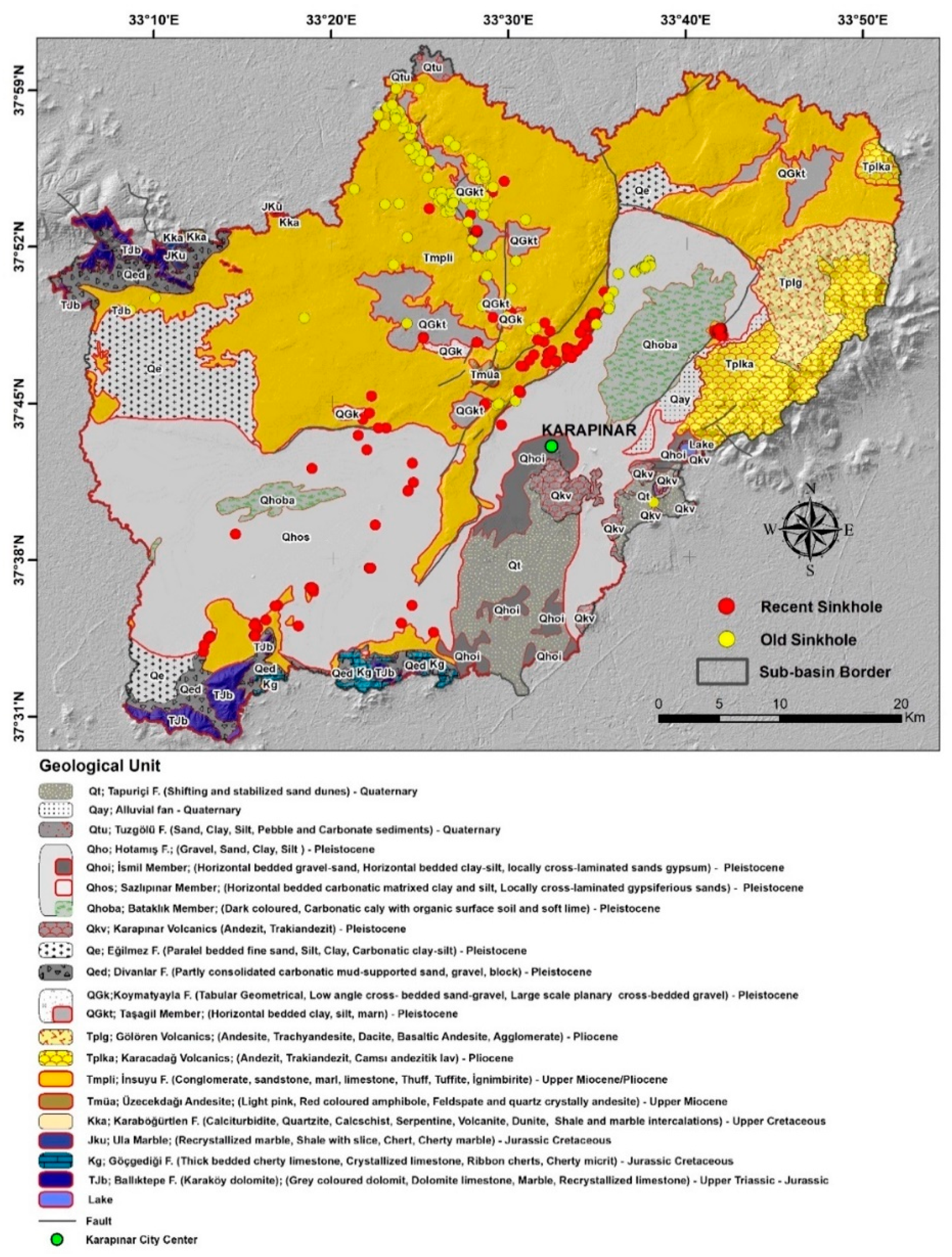
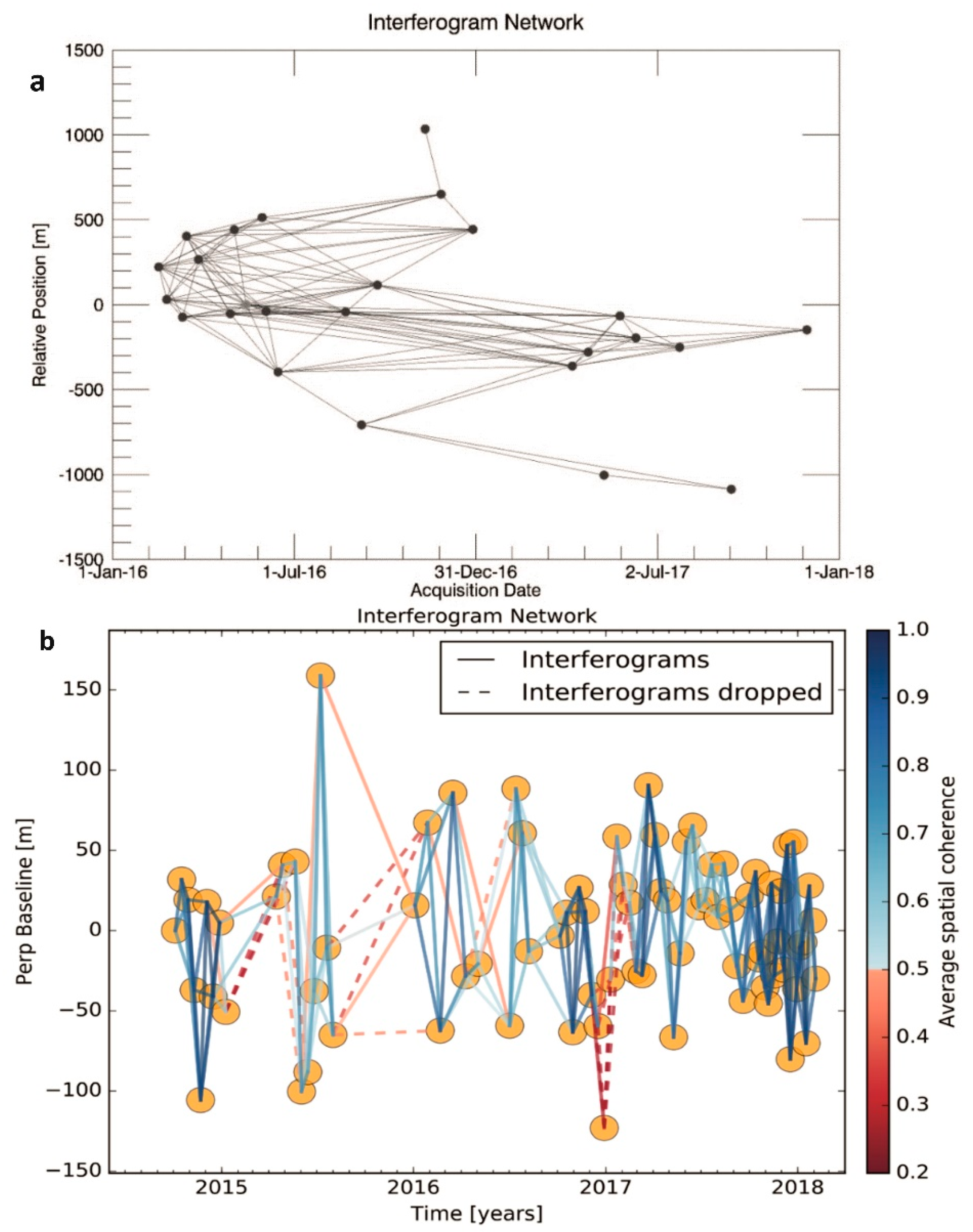
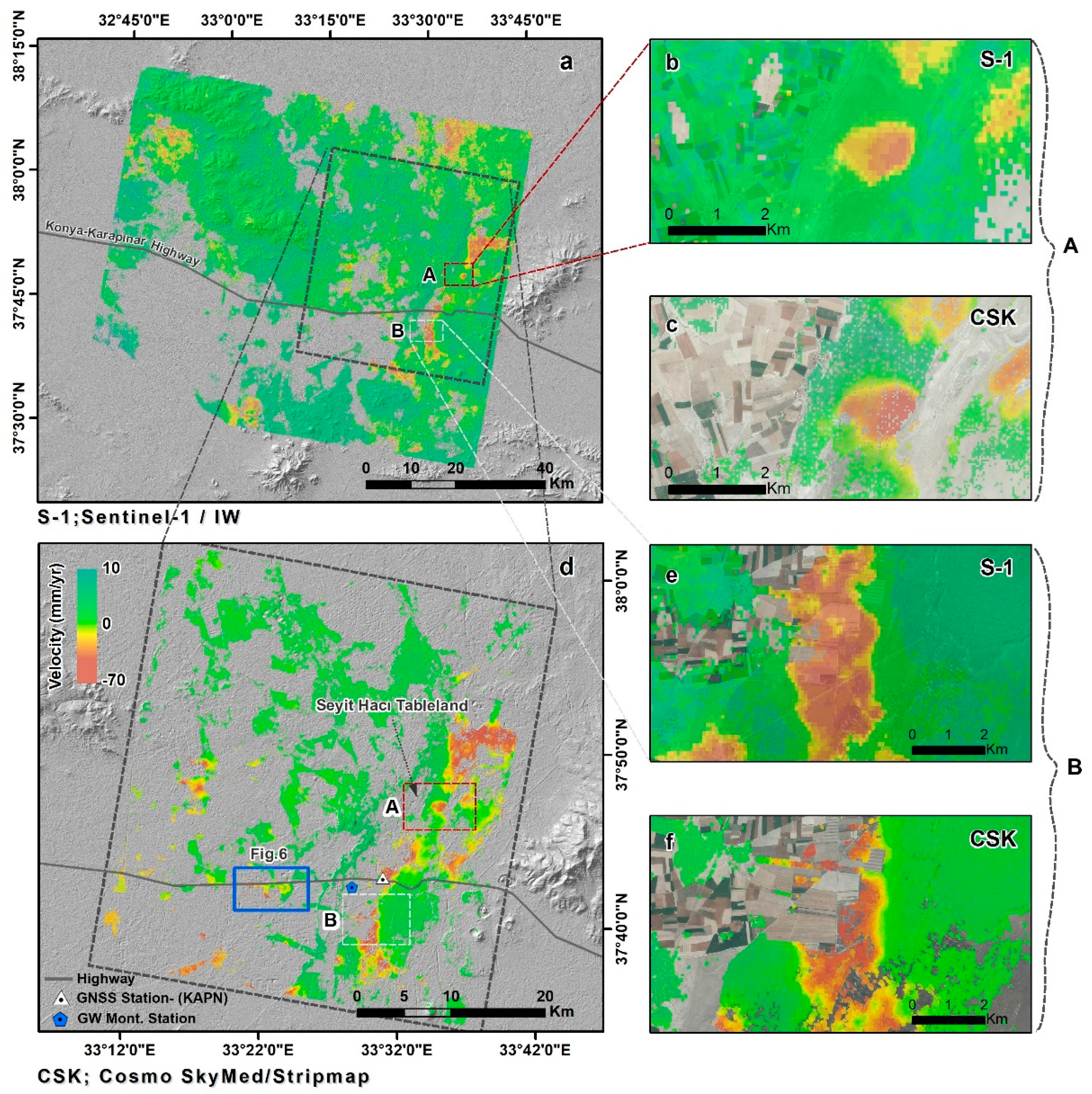
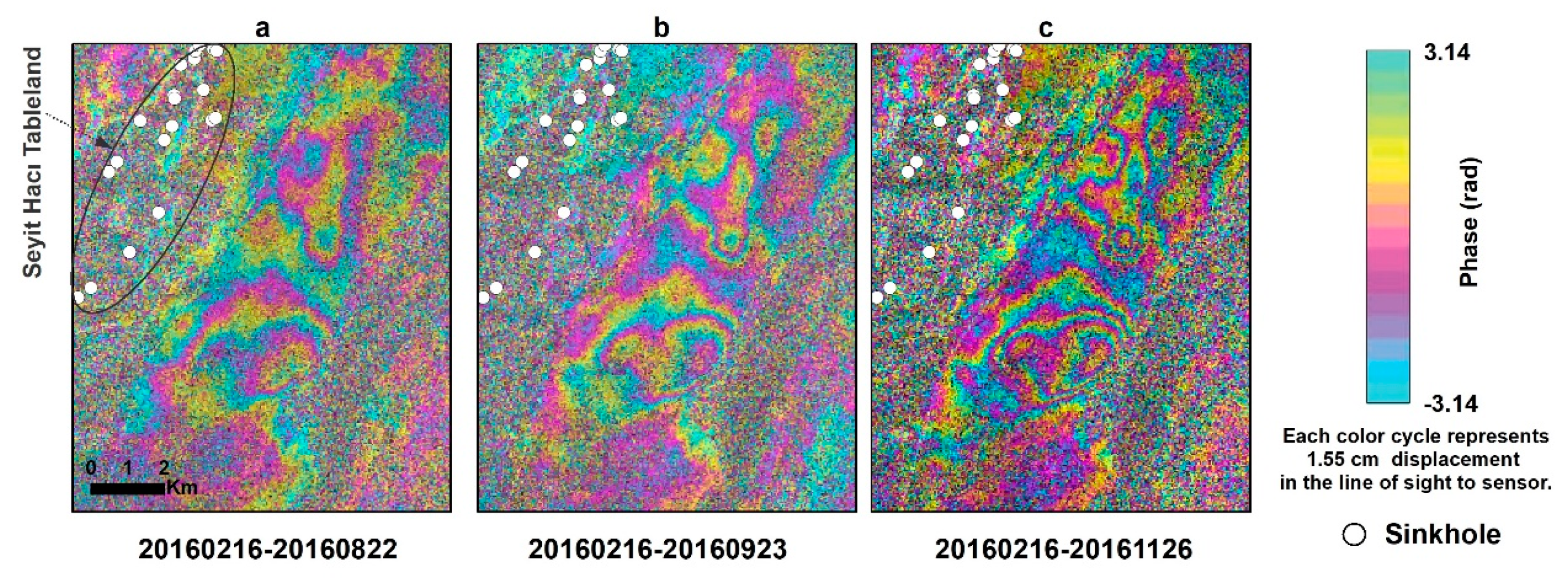
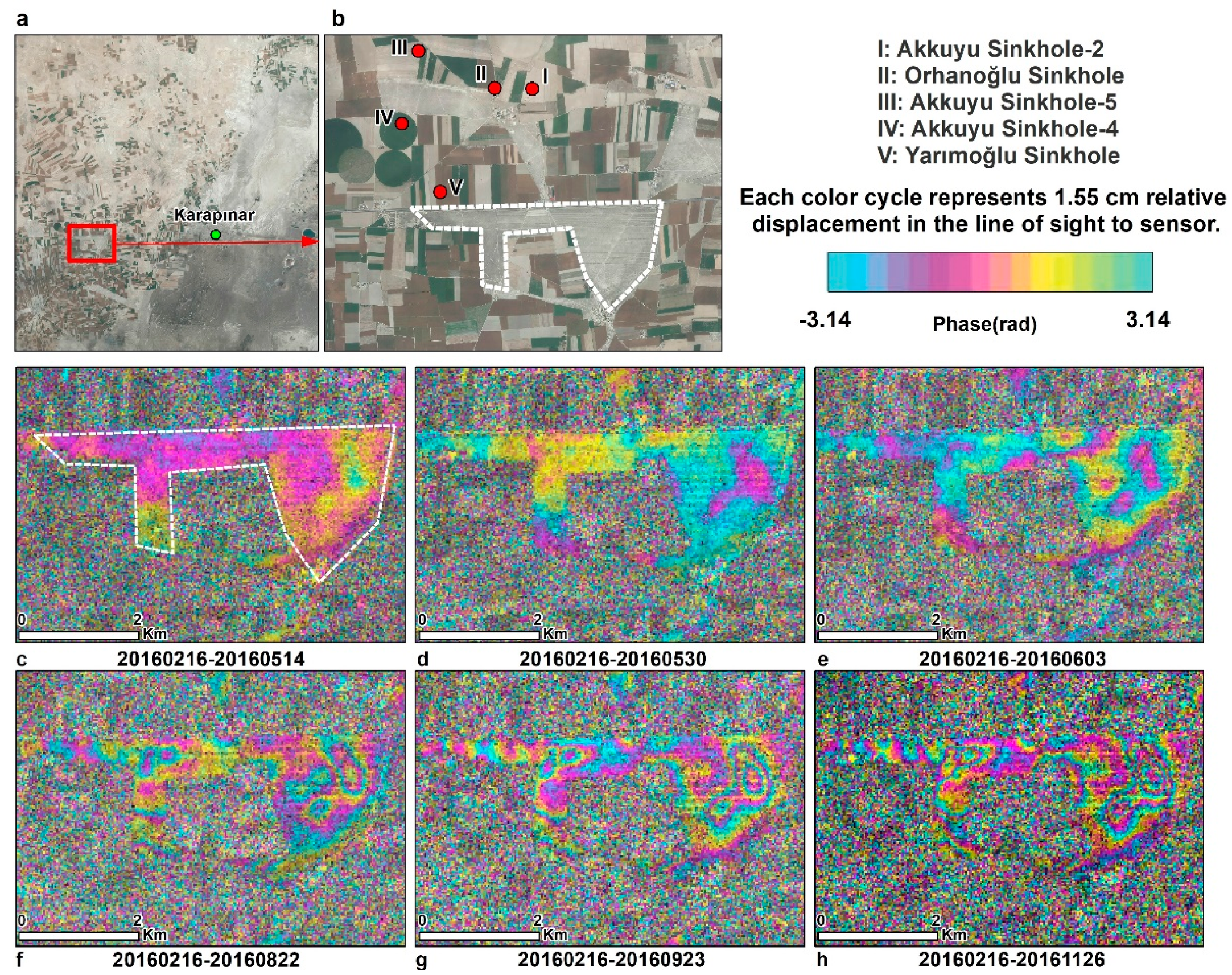

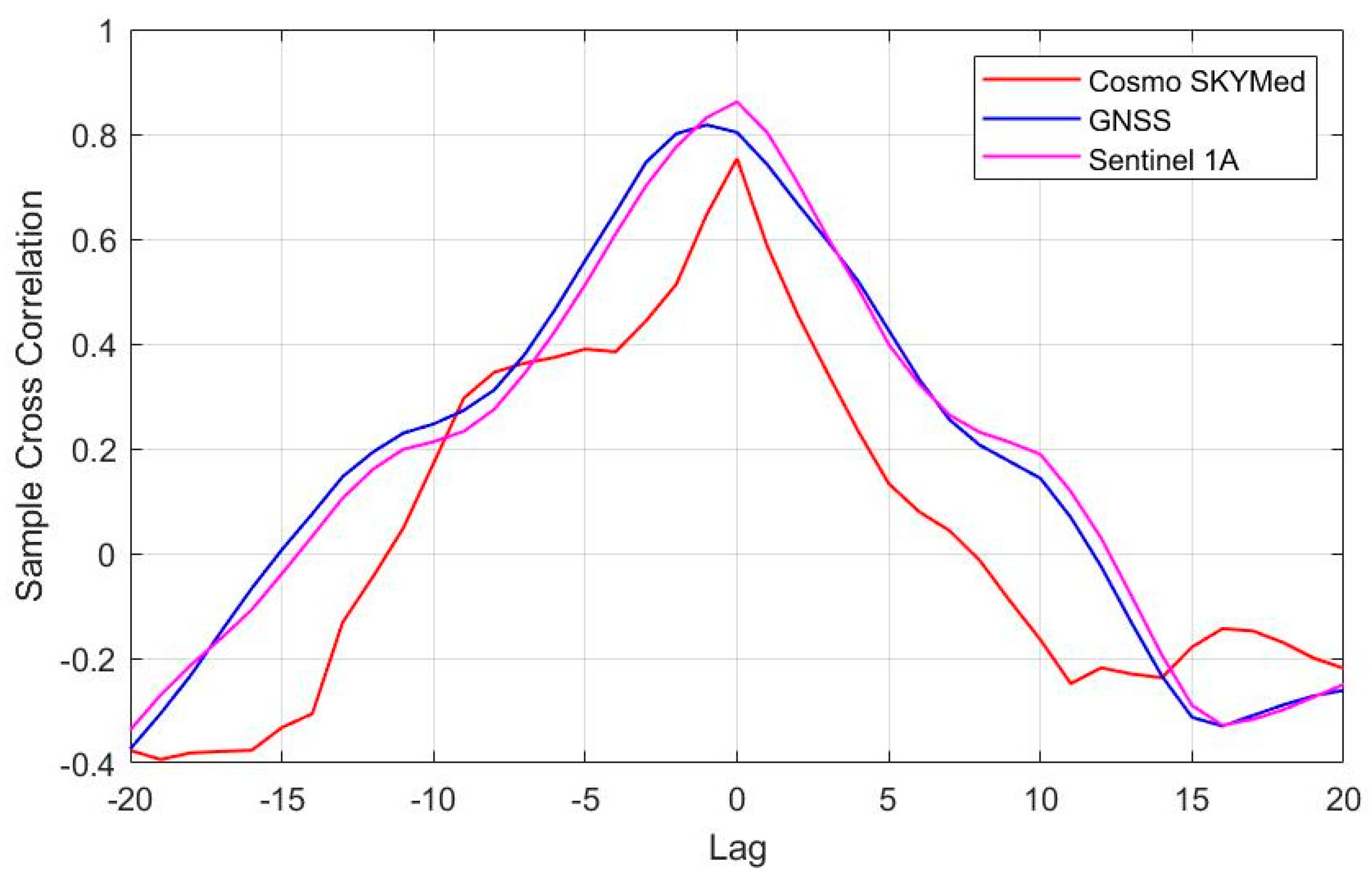

Publisher’s Note: MDPI stays neutral with regard to jurisdictional claims in published maps and institutional affiliations. |
© 2021 by the authors. Licensee MDPI, Basel, Switzerland. This article is an open access article distributed under the terms and conditions of the Creative Commons Attribution (CC BY) license (http://creativecommons.org/licenses/by/4.0/).
Share and Cite
Orhan, O.; Oliver-Cabrera, T.; Wdowinski, S.; Yalvac, S.; Yakar, M. Land Subsidence and Its Relations with Sinkhole Activity in Karapınar Region, Turkey: A Multi-Sensor InSAR Time Series Study. Sensors 2021, 21, 774. https://doi.org/10.3390/s21030774
Orhan O, Oliver-Cabrera T, Wdowinski S, Yalvac S, Yakar M. Land Subsidence and Its Relations with Sinkhole Activity in Karapınar Region, Turkey: A Multi-Sensor InSAR Time Series Study. Sensors. 2021; 21(3):774. https://doi.org/10.3390/s21030774
Chicago/Turabian StyleOrhan, Osman, Talib Oliver-Cabrera, Shimon Wdowinski, Sefa Yalvac, and Murat Yakar. 2021. "Land Subsidence and Its Relations with Sinkhole Activity in Karapınar Region, Turkey: A Multi-Sensor InSAR Time Series Study" Sensors 21, no. 3: 774. https://doi.org/10.3390/s21030774
APA StyleOrhan, O., Oliver-Cabrera, T., Wdowinski, S., Yalvac, S., & Yakar, M. (2021). Land Subsidence and Its Relations with Sinkhole Activity in Karapınar Region, Turkey: A Multi-Sensor InSAR Time Series Study. Sensors, 21(3), 774. https://doi.org/10.3390/s21030774






